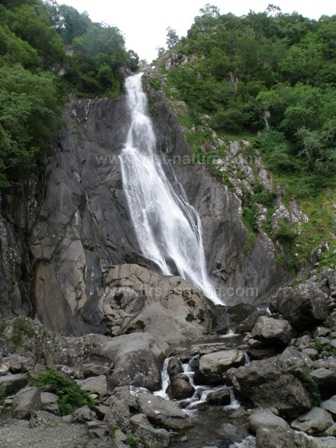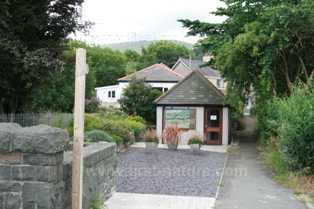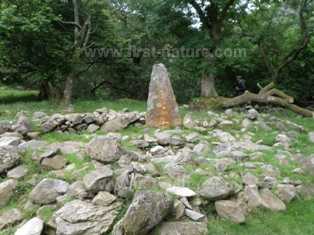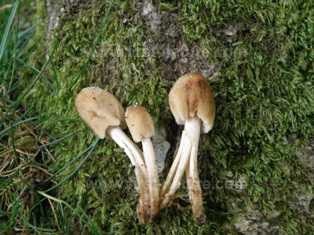Trees Birds Mammals Fish Amphibians Reptiles
Wild Algarve
Bookshop



Aber Falls - Coedydd Aber National Nature Reserve, Near Bangor, North Wales
Designations: part of the Coedydd Aber SSSI and Coedydd Aber SAC
Below: The famous waterfall at Coedydd Aber

The lovely walk up to the waterfall (Rhaeadr Fawr) is really good exercise, but nowhere near as taxing as walking up Snowdon or Cadair Idris. Along the way there is so much of interest to see and enjoy at any time of the year.
A network of paths running through the reserve makes it possible to return from the waterfall via a different route (through the woodland, for instance) and so to experience completely different views of the reserve and the surrounding area.
The reserve is managed by Natural Resources Wales (NRW).
Directions
Grid Ref: SH664710
On one of our recent visits we parked in the small free car park just off the A55 at Abergwyngregyn. From there we walked via the nearby Visitor Centre (pictured below), up through the village and into the nature reserve itself. This adds about half a mile to the walk.
It is also possible to park at a Pay-and-Display car park at Bont Newydd itself or at another Pay-and-Display car park slightly further on at the Forestry Commission site.
To get to Abergwyngregyn from Bangor take the A55 dual carriageway road towards Llandudno. Turn off at Junction 13, which is signed towards Abergwyngregyn, and then follow signs to the car park which is off to the left immediately before the road up into the village.
Below: The Visitor Centre and footpath entrance at Abergwyngregyn

Access
There is open access to Coedydd Aber throughout the year.
Part of the site is accessible for Wheelchair users, and the site staff and volunteers run guided walks for disabled people twice a year. For more information about the walks please call the CCW Help Line on 0845 1306229 or email...
Facilities
There are information boards throughout the reserve, a small unmanned visitor centre around 800 metres along the reserve track, and public toilets at the Forestry Commission Pay-and-Display Car Park.
There is a café in the village of Abergwyngregyn.
Description of Site
Rhaeadr Fawr, the big waterfall, is at the head of the River Aber, a small river that rises in the peaty moorland above this deep valley,. The waterfall is only one of fascinating things to look forward to when you set off on your walk at the lower end of the valley at Abergwyngregyn. There's wonderful scenery to enjoy along the way plus lots of historical interest, and then there's the abundance of wildlife that makes its home in this beautiful place.
Below: Recent excavations have been at this Iron Age Round House in the nature reserve

There is a long history of human habitation in the valley, and many archaeological finds have been made there including the remains of long huts, round huts and an Iron Age Hill Fort. Recent excavations have centred on the site of an Iron Age Roundhouse and grain drying kiln, which you can see on your way up to the waterfall.
The woodland in the steeper parts of the valley consists mainly of Sessile Oak (Quercus petraea), Downy Birch (Betula pubescens), Alder (Alnus glutinosa) and Hazel (Corylus avellana), but the richer soil of the valley floor has Ash (Fraxinus excelsior) and Wych Elm (Ulmus glabra).
In spring this area is a carpet of Bluebells (Hyacinthoides non-scripta) and other early wildflowers that make so many of the woodlands of Wales such a lovely places to visit at this time of the year.
Lady's-mantle (Alchemilla vulgaris) and Wild Angelica (Angelica sylvestris) grow on the steeper, rocky parts of the reserve while, closer to the river, you can find Ramsons (Allium ursinum) and the lovely little Town Hall Clock (Adoxa moschatellina). In high summer the reserve has impressive displays of Meadowsweet (Filipendula ulmaria).
Alder wood from the area was once used to produce clogs, which were sent from Wales to Lancashire. In the 1990s there was a programme to rejuvenate the alder woodland at Coedydd Aber. The trees were coppiced to promote new young growth and to improve regeneration from seed. As a result a small industry producing charcoal was built up, and this process is still carried out at the reserve from time to time.
The humid nature of the woodland makes it a great place for seeing ferns, mosses and lichens. Notable species at this reserve include two rare mosses, Fissidens rufulus and Philonotis rigida, and two unusual lichens Degelia plumbes and Lobaria amplissima. Another ususual plant found in significant numbers in the woodlands is Wood Horsetail (Equisetum sylvaticum); this particularly feathery horsetail is mainly confined to southern Britain and is uncommon in North Wales.

The woods at Coedydd Aber are, of course, a great place to see birds. Spring, when the migrant breeding birds arrive, is the best time to visit and see the many additional species that swell the resident bird population.
Pied Flycatchers (Ficedula hypoleuca), Wood Warblers (Phylloscopus sibilatrix), Tree Pipits (Anthus trivialis), Redstarts (Phoenicurus phoenicurus) and Wheatears are all present, and in the nearby Forestry Commission conifer plantation Crossbills (Loxia curvirostra) have been reported. The Great Spotted Woodpecker (Dendrocopos major) can be heard in the woods from spring onwards; and along the river look out for Dippers (Cinclus cinclus), Grey Wagtails (Motacilla cinerea). If you are really lucky you might also catch a glimpse of a Kingfisher (Alcedo atthis).
Closer to the waterfall Ring Ouzels (Turdus torquatus), Choughs (Pyrrhocorax pyrrhocorax) and Ravens (Corvus corax) can sometimes be seen on the steep rock walls.
Coedydd Aber, along with many of the oak woodlands in North Wales, is exceptionally good for fungi. Some of the species you might expect to find in Autumn include Fly Agaric (Amanita muscaria), Oakbug Milkcap (Lactarius quietus) and Turkeytail (Trametes versicolor).
The most notable mammal known to live in this nature reserve is a the weasel (Mustela nivalis), whose population is thriving on this reserve. You can also expect to see Bank Voles (Clethrionomys glareolus) and Wood Mice (Apodemus sylvaticus) here, too.
There really is something for everyone at this very famous nature reserve, and each time we go there we are rewarded with the sight of something new and different, which makes each visit a unique and memorable experience.